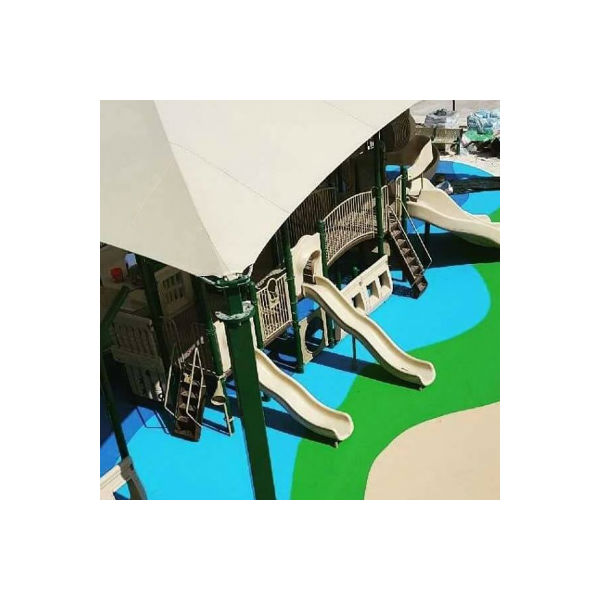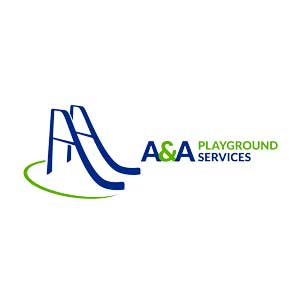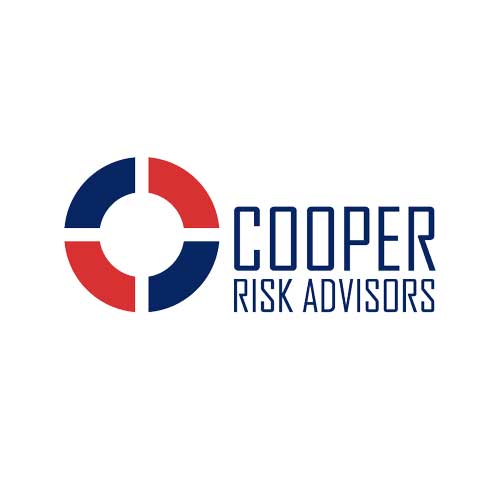Building it right is about creating safe play areas before, during, and long after the installation process.
Building a playground is not just about setting posts and bolting climbers and slides to it. A few years ago an installer installed an awesome new playground in a park. In order to save money, the job was split between the equipment and the surfacing into two separate contracts with two different companies. The park department was excited about the job and really pushed the supplier and installer to get the equipment manufactured, shipped, and installed. It took a little arranging, but they were able to work the schedule to meet the timeline.
The install was a week of hard work, and when it was over, the playground looked great. The park district signed off on the equipment and the installer cleaned up the site, removed the trash, and took down their construction fence. Right after the install was over, some bad weather hit, which made it impossible to get the surfacing installed. It was two weeks before the surfacing installer was able to do the job in a way that met manufacturer’s specifications. The delay was nobody’s fault – except maybe Mother Nature’s.
A group of neighborhood kids were at the park every day watching the playground go up. It had a tree house, a HUGE web climber, and a towering dragon slide. This was the coolest playground they had ever seen. The week it took to build the playground stretched out like the last 30 minutes before recess. Time stopped. Anticipation built. One day the kids went out and the playground was open! The installers were gone and the fence was down – time to play! It was everything they could have dreamed of. Their playground games were taken to a whole new level of awesomeness and intensity. They were climbing higher than ever and could almost touch the sky! And then it all took a tragic turn. Somebody fell. There was no surfacing yet.
Whose responsibility was it to secure the area after the playground was installed but before the surfacing was in? The playground installer? They had had their fence up already. It would be simple to just leave it up a while longer. The surfacing company was the one delayed. Could it be their responsibility? They had not arrived at the site yet – so was it even their site to begin with? What about the park district? It is their park!
The failure occurred simply because expectations were not set. Every party could have secured the site easily. The reality is, unless it is clearly defined, every party will assume it is someone else’s responsibility. With the current atmosphere of bidding jobs and getting the best price, jobs are approached as frugally as possible. Adding in something to a job that may not be required is the fastest way to lose the job. Safety is priority one, and expectations need to be communicated clearly to all involved parties.
Ensuring a Safe and Exciting Play Environment
There are four factors that ensure a safe and exciting play environment for children: the equipment and surfacing, the design and layout, proper maintenance and upkeep, and the installation of the equipment and surfacing. None of these factors are more important than the other and all are required to work together for a successful playground project.
ASTM International (ASTM) and the U.S. Consumer Product Safety Commission (CPSC) are constantly crafting standards and guidelines for the industry to follow. Architects and manufacturers work diligently to push the boundaries of play in a creative and safe manner. National Recreation and Park Association (NRPA) and National Program for Playground Safety (NPPS) have education programs to apply standards and create safety programs for public playgrounds. Companies like International Playground Safety Institute (IPSI) are creating programs which support maintenance and risk management in the public area. What about installation?
Does it really matter? Manufacturers work diligently to write precise installation instructions and generate scaled drawings. Installers just need to follow directions, right? Unfortunately, the world is not flat and sites have obstacles to contend with. There are rocks in the ground, water issues to deal with and soil conditions that vary widely.
The CPSC mentions “install” in its Handbook for Public Playground Safety 31 times indicating its importance in creating safe play areas. Compare this to “manufacture” (22) and “maintain” (19). The installer of the equipment is the ONLY entity guaranteed to be at the site and the ONLY entity that has a direct impact on proper installation of the equipment.
Most play areas are designed impeccably, manufactured perfectly, laid out on paper flawlessly, certified by the International Play Equipment Manufacturers Association (IPEMA), and complaint with ADA Accessibility Guidelines (ADAAG). If it is not installed correctly, it immediately becomes a potentially dangerous pile of metal and plastic with a bunch of worthless certifications. If the installer was not properly licensed and qualified, it also becomes a huge liability issue for everyone involved in the process. Further risk is created by an installer who does not know how to secure a jobsite or use heavy construction equipment safely in a public setting.
Utilizing a properly qualified park and playground equipment installer is just as important as any other part of the process. All manufacturers state in their warranty that a playground must be installed per manufacturer’s specifications by a qualified installer. If it is not, then their warranty is null and void, and they will refuse any liability or responsibility for the equipment. Hiring the lowest cost installer without qualifying them is the same as selling the warranty and product liability on the equipment for a pittance – a foolish choice considering that the cost of replacing a slide is generally in the thousands of dollars. The desire to appear fiscally responsible can have unintended consequences that may include the well-being of a child.
Qualifying a Playground Installer
How do we qualify a playground installer? What should your expectations be for the jobsite? How do you protect your interests? IPEMA certifies equipment. NRPA’s Certified Playground Safety Inspector (CPSI) program certifies inspectors. How do I find a legitimate installer?
The International Playground Contractors Association (NPCAI) was founded in 1997 by a group of passionate playground installers to address these concerns on behalf of the industry. Since their formation, they have established several programs to legitimatize the playground installation industry and to create a standard. The impact on the industry has been phenomenal. They have created an insurance program that has saved the industry hundreds of thousands of dollars solely on the strength and integrity of their membership. The Recreation Installation Specialist Certification (RISC) program has been embraced by installers and manufacturers as an effective way to define an installer and raise the standards for everyone. The Qualified Contractor program defines the minimum business criteria that a competent park and playground equipment installer should have.
It is the responsibility of the end user to utilize these programs to make sure that they are using competent and qualified contractors on projects. So how is this done?
- Require any contractor building a play area to be a Qualified Contractor under the NPCAI. There are over 100 qualified contractors in North America. The qualified contractor status is a third-party verification that the contractor is a legitimate playground installation business. Hiring a contractor that is not a qualified contractor would be identical to sourcing equipment from a manufacturer that does not think that it is important to get IPEMA certification. Knowingly allowing an installer that is not committed to safety and the proper installation of playground equipment to install your equipment is a disservice to your community. Qualified Contractor status requires the following:
- NPCAI Membership.
- Licensing – A Qualified Contractor should be a properly licensed contractor as required by their state or local community. State licensing requirements can be found at the NPCAI website.
- Insurance – The NPCAI verifies that the contractor carries proper liability and workers’ compensation insurance. A manufacturer’s product liability insurance is not adequate for a contractor and will not protect the owner against claims relating to the installation.
- CPSI – The NPCAI verifies that a member of the contracting organization is a current CPSI.
- RISC – The contractor should have an employee that has successfully completed the RISC certification under the NPCAI.
- Make sure that the manufacturer of the equipment approves of the company performing the installation of the equipment. Many manufacturers offer installer certification programs. A healthy working relationship between the sales representative, the manufacturer, and the installer is essential for proper communication during the installation process and the owner’s ability to maintain the equipment over its life.
- Installation Warranty – An Installation Warranty covers incidents that may occur over the life of the equipment than can be attributed to installation. The best installers offer a lifetime warranty on their installations because they know that if they install it per manufacturer’s specifications in the first place, their work should not be an issue and the manufacturer will take responsibility for any failures. If the manufacturer refuses to honor a warranty due to installation, this allows the owner to go to the installer to remedy the problem.
- Take the time to check other work by the installer. Make sure that the process went smoothly and the equipment performed as the manufacturer intended.
- Watch them work on a job. The way they present themselves, the condition of their equipment, and the way they organize their site is a huge reflection on how the crew is run. If an installer does not properly secure their site with a safety barrier, they are creating a hazard. Caution tape is NOT an acceptable way to do this. The minimum should be orange safety fencing.
Communicating Your Expectations
Hiring the right installer is the first step in a successful build. The next step is to effectively communicate expectations. Every job is different. Every school, park district, community, and agency works differently. It is not realistic to assume that an installer – even an installer with 25 years of experience – knows the owner’s expectations. There is no standard way to do a job. It is important to clearly state what you expect the installer to do and be responsible for. It is important for the installer to clearly understand what the owner expects from him in the playground build and what his responsibilities will be. The owner will want to know how the installer expects to execute the job.
What should be considered when setting expectations?
Site Preparation
- Who will remove and dispose of existing equipment and footings?
- If there is existing surfacing and drainage, who will move it out of the way? Does the drainage need to be preserved or is it being replaced?
- Is the site level? Who will level it? The recommended slope is 2% or less.
- Who will prepare the base? Unitary surfacing requires a solid base. If the base is not done per their specifications, then surfacing manufacturers will not stand behind their warranty.
- Is drainage necessary? Ever been to the Grand Canyon? Water affects everything over time. All playgrounds require a way to move water away from the equipment and surfacing. Improper drainage will also void warranties.
- What about access to the site? A playground is not accessible if there is no ADAAG compliant accessible path to the site. Who is responsible for this? A beautifully designed play area with colorful pour-in-place surfacing and concrete curbs was finished with no connecting path to the sidewalk. The sidewalk was two feet from the play area. Expectations were not set.
Equipment
- Who is receiving and storing the equipment? How will it get to the site? Who is responsible to receive, unload, and inventory the equipment? This is especially important if the supplier is contracted separately from the installer. Security of the equipment during the installation process must also be considered.
- Will the equipment fit into the area? Who verifies that the equipment will actually fit the site prior to installation? Sales representatives are an asset when it comes to planning and executing a playground project. Many have strong relationships with installers who can advise on complex jobs. Some sales organizations have their own in-house installers who make packaging and executing jobs a seamless process.
Installation Process
- What is adequate security for a jobsite and who is responsible? Is chain-link fencing needed or is orange fencing adequate? Generally the longer the job will take, the more important security is. Caution tape is never an acceptable solution.
- Who is responsible to check for utilities? Generally whoever is digging is responsible to order a utility check. If there are private utilities, there may be an added cost to mark them, and it should be clear who is responsible for these.
- What is the appropriate way to access the site? Does fencing need to come down? Is it OK to leave ruts from a skid steer or does the contractor need to grade these after the install?
- What is the acceptable time frame for the project to occur?
Surfacing
- Once again, who is responsible to secure the site? Pour-in-place or bonded rubber takes 72 hours to cure properly. Who will make sure no one gets on the surfacing for this time? Most surfacing companies have an exception to this written into their quotes and contracts and put the responsibility on the site owner.
- If the surfacing installer is different than the equipment installer, how will the site be secured in the interim? A play area without surfacing cannot be played on.
- Is bordering required? Who is responsible for that?
Post Install
- What is the expectation for the appearance of the site when the job is done?
- Who is responsible for backfilling around concrete? Is seeding or sodding needed?
- Is a rough final grade acceptable or is a fine grading needed?
- Who is responsible for the final inspection? How will punch lists be handled? What should the installer do with the maintenance kit?
- A written statement that the equipment was installed per manufacturer’s specifications should be given to the owner from the installer.
This is by no means an exhaustive list, but it should create awareness of the different factors that need to be considered when working with a good installer. Much more in depth training is available from the NPCAI with their RISC program. It is a three day training on all aspects of park and playground equipment installation with a test at the end. The best part is that it is held in Las Vegas, Nevada in December and Orlando, Florida in January. Playworld Systems and BCI Burke have both incorporated the RISC program into their installer certification courses to demonstrate their commitment to a high installation standard for their play areas.

Building it right is about creating safe play areas before, during, and long after the installation process. It is about extending the life of the play equipment and protecting everyone’s liability exposure for the life of the area. Most importantly, building it right is about creating environments that enable kids to simply go nuts and be kids in their very own place – the playground.





















Add new comment